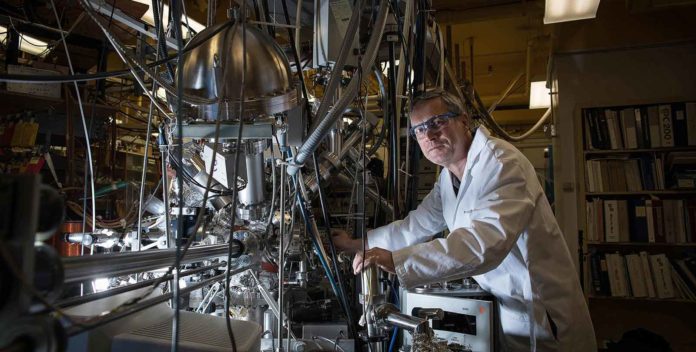Although plentiful in modern Earth’s atmosphere, molecular oxygen is extremely rare in space. Only trace amounts have been found elsewhere in our solar system and in interstellar clouds.
The source of that oxygen remained a mystery until two years ago when scientists at Caltech proposed the existence of a new chemical process that could account for its production. They have now demonstrated a new reaction for generating the oxygen that could help humans explore the universe and perhaps even fight climate change at home.
According to scientists, their reaction represents a new kind of chemistry discovered by studying comets. They suggest that some unusual reactions can occur by providing kinetic energy. When water molecules are shot like extremely tiny bullets onto surfaces containing oxygen, such as sand or rust, the water molecule can rip off that oxygen to produce molecular oxygen.
This reaction occurs on comets when water molecules vaporize from the surface and are then accelerated by the solar wind until they crash back into the comet at high speed.
Comet, on the other hand, emits carbon dioxide (CO2). In the experiments, scientists wanted to check if the production of CO2 could also generate molecular oxygen in collisions with the comet surface.
When they discovered oxygen in the stream of gases coming off the comet, they needed to affirm that the reaction was like water’s reaction. They planned an experiment to crash CO2 onto the inert surface of gold foil, which can’t be oxidized and ought not to create molecular oxygen. In any case, O2 kept on being transmitted from the gold surface. This implied the two particles of oxygen originate from a similar CO2 molecule, successfully part it in an extraordinary way.
Konstantinos P. Giapis, a professor of chemical engineering at Caltech said, “At the time we thought it would be impossible to combine the two oxygen atoms of a CO2 molecule together because CO2 is a linear molecule, and you would have to bend the molecule severely for it to work. You’re doing something really drastic to the molecule.”
“Understanding the reaction posed a significant challenge because of the possible formation of excited molecules. These molecules have so much energy that their constituent atoms vibrate and rotate around to an enormous degree. All that motion makes simulating the reaction in a computer more difficult because the atoms within the molecules move in complex ways.”
Tom Miller, professor of chemistry said, “In general, excited molecules can lead to unusual chemistry, so we started with that. But, to our surprise, the excited state did not create molecular oxygen. Instead, the molecule decomposed into other products. Ultimately, we found that a severely bent CO2 can also form without exciting the molecule, and that could produce O2.”
The apparatus designed for the experiment, proficiently works like a particle accelerator, turning the CO2 molecules into ions by giving them a charge and then accelerating them using an electric field at much lower energies.
Giapis said, “You could throw a stone with enough velocity at some CO2 and achieve the same thing. It would need to be traveling about as fast as a comet or asteroid travels through space.”
That could explain the presence of small amounts of oxygen that have been observed high in the Martian atmosphere. There has been speculation that the oxygen is being generated by ultraviolet light from the sun striking CO2, but Giapis believes the oxygen is also generated by high-speed dust particles colliding with CO2 molecules.
He hopes that a variation of his reactor could be used to do the same thing at more useful scales—perhaps one day serving as a source of breathable air for astronauts on Mars or being used to combat climate change by pulling CO2, a greenhouse gas, out of Earth’s atmosphere and turning it into oxygen. He acknowledges, however, that both of those applications are a long way off because the current version of the reactor has a low yield, creating only one to two oxygen molecules for every 100 CO2 molecules shot through the accelerator.
Giapsis said, “Is it a final device? No. Is it a device that can solve the problem with Mars? No. But it is a device that can do something that is very hard. We are doing some crazy things with this reactor.”
The study is published in the journal Nature Communications.
